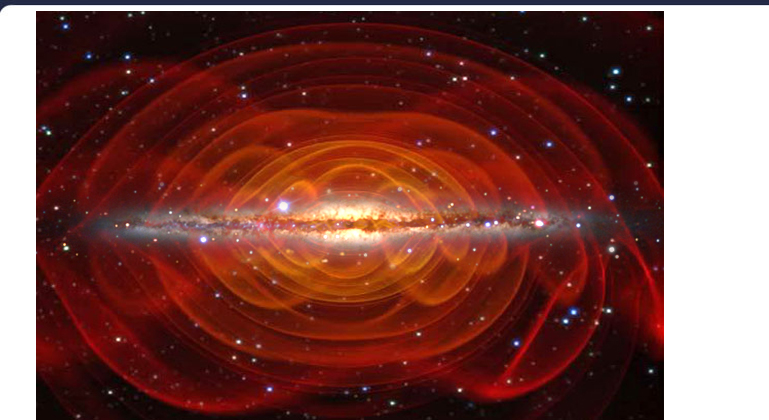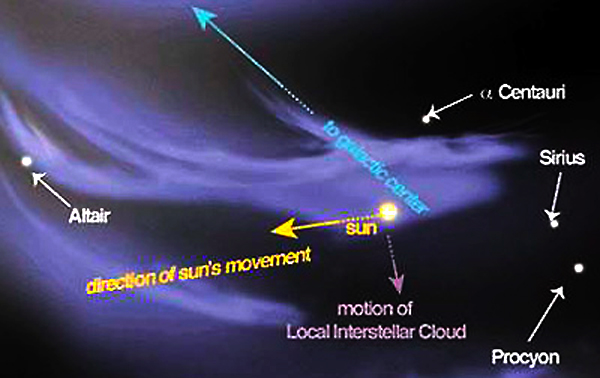




Infrasound Resonance in Galactic Standing Waves
Mystery Behind Solar System's Giant Ribbon Solved?
by Ian O'Neill for Discovery News
January 15, 2010
Last year, NASA's Interstellar Boundary Explorer (IBEX) made a discovery so profound that scientists had a hard time describing what they were seeing. A vast ribbon located in the outermost reaches of the solar system had been spotted, a structure that had never been seen before. Now scientists believe the shape might be created by a huge reflection caused by particles bouncing off a galactic magnetic field.

IBEX isn't an ordinary space telescope and this mystery ribbon isn't emitting any light; the ribbon is in fact the source of very energetic neutral particles that are raining down on us after travelling over 100 AU (approximately 9 billion miles).
IBEX is designed to detect fast moving particles called energetic neutral atoms (or ENAs for short) created at the absolute boundary of our solar system known as the "heliopause." This boundary separates the bubble-like heliosphere (which contains the sun, planets and solar wind) and interstellar space (i.e. the space between the stars).
Our sun is continuously pumping out energetic protons as the solar wind, and eventually these protons are carried to the heliopause. At this point, a process known as "charge exchange" can occur between these fast moving solar protons and slow moving neutral atoms (usually hydrogen) originating from interstellar space.
Should the two types of particles collide, the energetic solar particles can steal an electron from the interstellar neutral atoms, thereby producing ENAs. Some of these ENAs are then fired back toward Earth.
This interaction can be detected by IBEX as they travel in a straight line and not deflected by any magnetic fields. The satellite then traces the ENAs back to their origin, producing a map of the heliosphere. In the case of the "ribbon discovery," IBEX was seeing intense ENA production from a mystery structure that appeared to be located beyond our solar system.
Now, this is where things start to get really interesting.
In December it was announced that the veteran Voyager probes currently flying toward the heliosphere measured an unexpected increase in magnetic field strength. Scientists believe that this increase is due to an unexpectedly large magnetic field threaded through a cloud of interstellar gas called the "Local Fluff." Our solar system is currently speeding into this Fluff.
In research that was published in the Astrophysical Journal Letters, Jacob Heerikhuisen, a NASA Heliophysics Guest Investigator from the University of Alabama in Huntsville, believes the ribbon observed by IBEX is caused by an interstellar magnetic field, possibly relating to the Voyager probes' discovery.
"We believe the ribbon is a reflection," said Heerikhuisen. "It is where solar wind particles heading out into interstellar space are reflected back into the solar system by a galactic magnetic field."
Therefore, the energetic protons traveling inside the solar wind encounter this "galactic magnetic field" and are manipulated in such a way that they are reflected back to where they came from (U-turn style).
It's as if the solar protons "bounce" off an invisible magnetic wall. Then they undergo charge exchange to produce the ENAs. The ribbon-like structure IBEX is seeing is therefore a previously unknown (and rather eerie) magnetic field that exists beyond the heliosphere.
"This is an important finding," said Arik Posner, IBEX program scientist at NASA Headquarters. "Interstellar space just beyond the edge of the solar system is mostly unexplored territory. Now we know, there could be a strong, well-organized magnetic field sitting right on our doorstep."
This all sounds very exciting, but does IBEX have a practical purpose? Actually, yes, it could be used as a cosmic ray weather forecaster.
By monitoring the shape and distribution of this ENA ribbon, we can see how it changes with time. As the solar system passes through interstellar space (and the Local Fluff), this external magnetic field can squash and squeeze our heliosphere. When this happens, highly energetic (and damaging) cosmic rays can penetrate deeper into our solar system.
This could potentially have huge implications for life on Earth and future human spaceflight plans, as let's face it, cosmic radiation is well known for causing damage to anything organic.

NASA Reports Earth Close to Unexpected Interstellar Cloud, a "Local Fluff"
by Linda Moulton-Howe for Earthfiles.com
December 26, 2009
"The Voyager's (spacecraft launched in 1975) are not actually inside the Local Fluff. But they are getting close and can sense what the cloud is like as they approach it... There could be interesting times ahead!" - Merav Opher, Ph.D., NASA Heliophysicist
Voyager 1 entered the surprising heliosheath in Dec. 2004; Voyaer 2 followed almost 3 years later in Aug. 2007. These crossings were key to discovering the unexpected interstellar cloud, or galactic "fluff".
NASA reports "the Fluff is held at bay just beyond the edge of the solar system by the sun's magnetic field, which is inflated by solar wind into a magnetic bubble more than 10 billion kilometers wide. Called the heliosphere, this bubble acts as a shield that hepls protect the inner solar system from galactic cosmic rays and interstellar clouds. The two Voyagers are located in the outermost layer of the heliosphere, or heiosheath, where the solar wind is slowed by the pressure of interstellar gas. The fact that the Fluff is strongly magnetized means that other clouds in the galactic neoghborhood could be, too. Eventually the solar system will run into some of the Fluff, and its strong magnetic fields could compress the heliosphere even more than it is compressed now. Additional compression could allow more cosmic rays to reach the inner solar system, possibly effecting terrestrial climate and the ability of astronauts to travel safetly through space."
Analysis
The concept of 'local fluff' as put forth by NASA is silly - in reality these interstellar plasma sheets form because of cyclical energy pulses moving through the spiral arms of our galaxy. The plasma sheets that our whole solar system is now approaching are composed of interstellar gasses that become ionized by galactic waves which pulse rhythmically from the Central Sun, around which our whole galaxy rotates. The spiral galactic form is shown above with the underlying macro-structure of ultra-low frequency infrasound standing waves that emanate from the Central Sun.
The Sanskrit motherculture that has left a worldwide network of pyramids in monumental stone on every continent, provides us with a comprehensive set of prophecies and advanced scientific predictions based on the the ayurvedic knowledge of the akashic field of infrasound standing waves which encircles the planet. Profound scientific details concerning this ongoing shift in both the physical reality of our planet and the consciousness of humanity are shared in Betelgeuse & the Red Dawn.
The golden radiation of these plasma sheets that Earth now approaches is contributing to the increasing intensity of solar storms and terrestrial infrasound resonance, which is causing spates of piezoelectric infrasound fires and localized events of natural electrical surges as in Pekanbaru, Indonesia and Soesterberg, Netherlands. These events will continue to increase in intensity towards their culmination during the magnetic reversal of December 22, 2012.